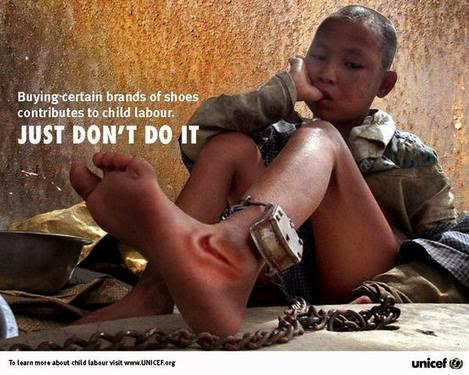This advertising
campaign was created by Unicef (the United Nations children's fund) in order to
persuade viewers not to purchase products of certain brands which contribute to
child labour. By showing the child in the leg-iron and the scar of a burn which
shows the Nike brand (accused of using child labour), this advert attempts to
evoke guilt in viewers about buying goods from that famous brand.
This persuasion
technique of emotional appeal is known as a 'guilt appeal'. Research suggests
that there are three types of guilt: existential, anticipatory and reactive
guilt (Rawlings, 1970). Individuals feel existential guilt when one feels more
fortunate and has a more sense of well-being than others. Anticipatory guilt
occurs when one believes that he/she will violate a value or norm in the future
with unacceptable behaviour. Reactive guilt is experienced in response to an
overt act of infringing a social norm. According to the above definitions, it
seems likely that the possible type of guilt message receivers of the advert
may feel is anticipatory guilt.
Renner and
colleagues (2013) conducted a study investigating the distinct effects of
anticipatory versus reactive guilt appeals. Their participants all received a call
for blood donation which contained the expectation of the guilt appeals and
reference group manipulations. Participants in the reactive guilt scenario
heard the message that low blood donation rates were because individuals like
themselves did not donate blood, whilst those in the anticipatory guilt
scenario were told that if they stop donating blood in the future there won't
be enough blood in blood banks. Participants heard the messages either from
people with a special expertise in the field of blood donation or from those
with no expertise. After exposure to the blood donation appeal, they completed
a questionnaire examining their attitude toward the appeals.
As shown in the
figure above, it was found that people exposed to the anticipatory guilt appeal
had a more positive attitude toward the appeal than those told the reactive
guilt scenario. But whether an expert tells individuals the message or not,
their attitude toward the appeal was not significantly different. If the
present advertising campaign had used reactive guilt appeals to persuade people
it would not have been a more effective way.
Rawlings, E. I. (1970). Reactive guilt and
anticipatory guilt in altruistic behavior. In J. Macaulay & L. Berkowitz
(Eds.), Altruism and helping behavior
(pp. 163–177). New York, NY: Academic Press.
Renner, S., Lindenmeier, J., Tscheulin, D.
K., & Drevs, F. (2013). Guilt appeals and prosocial behavior: An
experimental analysis of the effects of anticipatory versus reactive guilt
appeals on the effectiveness of blood donor appeals. Journal of Nonprofit & Public Sector Marketing, 25, 237-255.



No comments:
Post a Comment
Note: Only a member of this blog may post a comment.